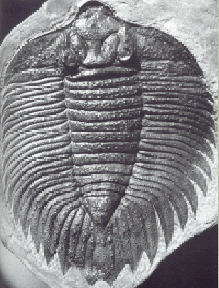|
The Order
LICHIDA (Moore, 1959)
A typical feature of the representatives of this order is the closely granulated (Granum, Lat. grain) or tuberculated (Tuberculum, Lat. tuberculum) exoskeleton. As a rule, cephalon, thorax or pygidium are spined prominently. The LICHIDA are including the Superfamilies Lichoidea, Odontopleuroidea and Dameselloidea.
The images shows a
representative of the Superfamily Lichoidea (Family Lichidae). |
Actinurus occidentalis (Source: Trilobites, Levi-Setti, 1993)
|
|
Epoch Lower Ordovician to Upper Devonian. A great Glabella which extends up to the anterior cephalic border is typical. The development and differentiation of the Cephalons ranges from simple up to complex structures. The sutures are running ophistoparian. As a rule, the eyes (holochroal) are present, developed however mostly smallish. The LICHIDA have a conterminant hypostome.
The development varies and the thorax is composed of 8- 13 segments. The pleura are normally ending in pleural spines that for their part are varying in length and development again. Furthermore rachis and pleura featuring dorsal sided spines is possible.
With the exception of the representatives of Odontopleuroidea (very small pygidium), the big tail shield is designed often longer than broad. The pygidial edge can feature spinous structures. One finds 3 pairs of pleura, passing into spines (variable design).
|
|
